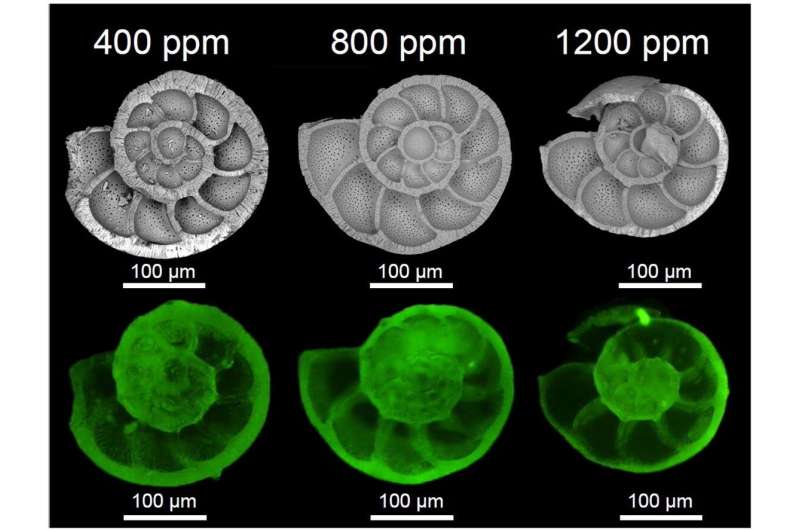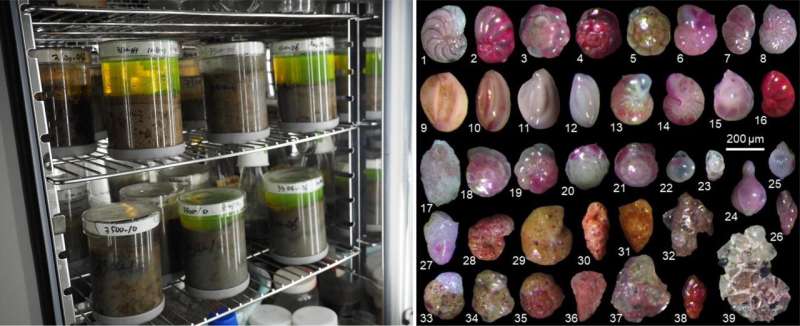July 13, 2023 feature
This article has been reviewed according to Science X's editorial process and policies. Editors have highlighted the following attributes while ensuring the content's credibility:
fact-checked
peer-reviewed publication
trusted source
proofread
Acidifying oceans will cause a diversity and survival crisis for microscopic marine organisms, finds research

Oceanic responses to climate and human interactions have been studied for decades. In recent years the effects of increasing ocean acidity have been featured, with stark images of coral reefs being decimated by bleaching.
Acidification results from ocean-atmosphere interactions, whereby carbon dioxide from the atmosphere is drawn down, reacting with water molecules to form carbonic acid. This then further breaks down into hydrogen ions and bicarbonate ions, with the former causing a reduction in pH.
Corals are not the only marine organisms to be made up of calcium carbonate and therefore susceptible to ocean acidification however. Single-celled organisms known as foraminifera produce chambered shells of calcium carbonate, and they are an important part of marine food chains, being primary and secondary consumers. Most tend to be benthic, where they live in or at the seafloor, but a smaller proportion are planktonic, living within the water column.
New research, published in Geoscience Frontiers, has focused on the impact of acidification on benthic foraminifera living on the continental shelf of the West Pacific Ocean. Researchers at the Institute of Oceanology in the Chinese Academy of Sciences conducted experiments for eight months on foraminifera cultures taken from four sites in the Yellow Sea, involving 4,626 specimens attributed to 39 species. They tested foraminifera response to marine conditions when progressively more carbon dioxide (400ppm, 800ppm, 1200ppm and 1600ppm) was fed into the system. This reflects modeling scenarios reported by the Intergovernmental Panel on Climate Change (IPCC) where worse-case scenario simulations are based upon carbon dioxide concentrations of 1,600 ppm and above.

From the experiments, the scientists found that there was an overall decrease in benthic foraminifera abundance in response to increasing acidity, while shell diameter and thickness (and therefore weight) also reduced as there was less calcium carbonate in the ambient environment from which to build their shells. This reduction in weight and size (dwarfism) is attributed to the foraminifera attempting to preserve the energetic costs of obtaining calcium carbonate from an ever-smaller reserve in the surrounding water.
Under conditions with carbon dioxide concentrations of 800ppm and 1,200ppm, the researchers found that foraminifera calcium carbonate shell deposits on the seafloor would be reduced by ~50% and 90% respectively, something they deem a "biocalcification crisis." However, there was also an interesting increase in diversity, as the challenging conditions seemingly stimulated the emergence of rarer species.
Further research by lead author Shuaishuai Dong, reported in Frontiers in Marine Science, also revealed how temperature and salinity can impact the coiling direction of benthic foraminifera. A 13-month experiment, again using samples from the intertidal zone of the Yellow Sea, subjected the foraminifera cultures to three different temperatures and four salinities to test whether the organisms responded by coiling in a left spiral (sinistral) or right spiral (dextral).
One particular foraminifer, Ammonia aomoriensis, dominated the test assemblage and was found to have a sinistral coiling preference in response to increasing temperature, but no significant impact from increasing salinity. The larger the foraminifer, the more sinistral the coil also. The authors note that the same phenomenon has been found to occur in planktic foraminifera, based upon previous research of species such as Globorotalia truncatulinoides.
This research shows how even some of the smallest organisms on our planet are impacted by the big actions of humanity. To mitigate against the harsh reality of our impact on the world around us, we must tackle climate change—not just for the large organisms that are easy for us to see in decline, but for the small ones we may need a microscope to understand too.
More information: Shuaishuai Dong et al, Biocalcification crisis in the continental shelf under ocean acidification, Geoscience Frontiers (2023). DOI: 10.1016/j.gsf.2023.101622
Shuaishuai Dong et al, New evidence for coiling direction of benthic foraminifera as a temperature proxy, Frontiers in Marine Science (2023). DOI: 10.3389/fmars.2023.1122189
Journal information: Geoscience Frontiers , Frontiers in Marine Science
© 2023 Science X Network




















